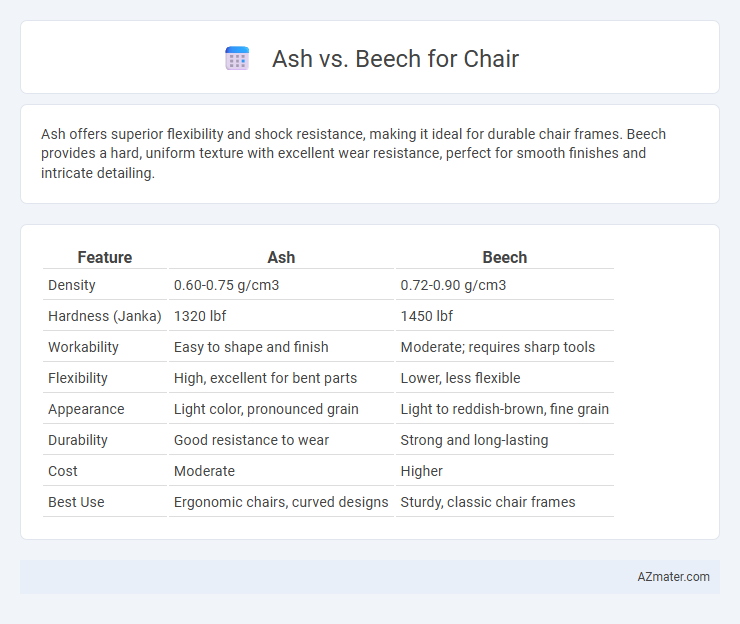Ash offers superior flexibility and shock resistance, making it ideal for durable chair frames. Beech provides a hard, uniform texture with excellent wear resistance, perfect for smooth finishes and intricate detailing.
Table of Comparison
| Feature | Ash | Beech |
|---|---|---|
| Density | 0.60-0.75 g/cm3 | 0.72-0.90 g/cm3 |
| Hardness (Janka) | 1320 lbf | 1450 lbf |
| Workability | Easy to shape and finish | Moderate; requires sharp tools |
| Flexibility | High, excellent for bent parts | Lower, less flexible |
| Appearance | Light color, pronounced grain | Light to reddish-brown, fine grain |
| Durability | Good resistance to wear | Strong and long-lasting |
| Cost | Moderate | Higher |
| Best Use | Ergonomic chairs, curved designs | Sturdy, classic chair frames |
Introduction: Choosing the Right Wood for Chairs
Ash wood offers exceptional strength and flexibility, making it ideal for durable, ergonomic chairs that can withstand daily use. Beech wood is prized for its fine grain and smooth finish, providing a sleek, polished look often favored in modern chair designs. Selecting between ash and beech depends on the desired balance of robustness and aesthetic appeal in chair construction.
Ash vs Beech: An Overview
Ash wood is known for its light color, distinctive grain patterns, and exceptional strength, making it highly durable for furniture like chairs. Beech wood offers a uniform texture and smooth finish, with moderate hardness and impressive shock resistance, ideal for crafting sturdy seating. When comparing ash vs beech for chairs, ash typically provides greater flexibility and resilience, while beech excels in workability and consistent appearance.
Appearance and Grain Comparison
Ash wood features a pale, creamy color with a straight, pronounced grain that offers a clean, modern aesthetic for chairs. Beech displays a more uniform, light reddish-brown hue with a tight, fine grain, giving furniture a smooth and consistent appearance. The contrasting grain patterns and color tones between ash and beech influence the visual warmth and style of chair designs.
Strength and Durability
Ash wood is highly regarded for its exceptional strength and flexibility, making it a popular choice for durable chairs that withstand daily use. Beech wood offers comparable hardness and resistance to wear, ensuring long-lasting stability and support in chair construction. Both woods exhibit excellent shock resistance, but ash tends to be slightly lighter while maintaining robust durability.
Workability and Craftsmanship
Ash wood offers excellent workability due to its straight grain and moderate hardness, making it ideal for finely crafted chairs with smooth finishes. Beech wood is highly favored in craftsmanship for its uniform texture and exceptional bending strength, allowing intricate shaping and durability in chair construction. Both woods provide a balance of strength and aesthetic appeal, with ash excelling in shock resistance and beech delivering superior machinability for detailed joinery.
Comfort and Ergonomics
Ash wood offers excellent comfort and ergonomics for chairs due to its natural flexibility and smooth grain, providing gentle support and durability during prolonged use. Beech wood is highly favored for ergonomic chair design because of its firm, dense structure, which ensures stability and promotes proper posture. Both woods balance comfort and support, with ash delivering a slightly softer feel and beech emphasizing robust ergonomic performance.
Sustainability and Environmental Impact
Ash wood is highly sustainable due to its fast growth rate and ability to regenerate quickly, making it a renewable resource for chair manufacturing. Beech wood offers a low environmental impact by being widely available in Europe and sourced from responsibly managed forests, ensuring minimal deforestation. Both woods have excellent durability and recyclability, contributing to eco-friendly furniture production and reducing landfill waste.
Cost Differences: Ash vs Beech
Ash wood typically costs more than beech due to its greater durability and distinctive grain patterns favored in furniture making. Beech wood offers a more affordable option while still providing good strength and a smooth finish suitable for chair construction. Price variations depend on factors like wood grade, sourcing, and regional availability, impacting overall chair production costs.
Best Applications: When to Choose Ash or Beech
Ash wood excels in applications requiring high shock resistance and durability, making it ideal for chairs subject to heavy use or outdoor settings. Beech wood offers a smooth finish and impressive strength, best suited for indoor chairs with intricate designs or fine craftsmanship. Selecting ash is optimal for robust, flexible seating, while beech shines in aesthetic appeal and stability under consistent indoor conditions.
Final Verdict: Which Wood Wins for Chairs?
Ash wood offers exceptional strength and shock resistance, making it ideal for durable and flexible chair frames. Beech wood provides a tight grain, high hardness, and smooth finish, resulting in sturdy chairs with excellent wear resistance. For long-lasting chairs that combine resilience with a refined appearance, beech wood slightly outperforms ash due to its superior hardness and ability to withstand heavy use.

Infographic: Ash vs Beech for Chair
 azmater.com
azmater.com